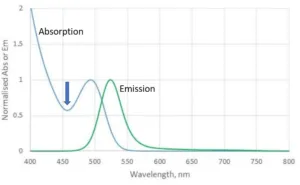By now most readers of Display Daily have probably hear about QD-OLED technology. As the resident QD expert, I’ll share my thoughts on the promise and challenges of this technology which has been reported on Display Daily recently.

It’s no secret that QLED and OLED displays have been competing head-to-head (at least in the premium TV market) for the past few years. This ever-present battle between Samsung and LG has had both sides promoting the major benefits of their own technology while pointing out the downside of the other.
|
|
QLED Benefits |
OLED Benefits |
 |
Wide color gamut Brightness Relies on existing LCD tech Stability |
Thin form factor Deep blacks Excellent viewing angle |
|
|
QLED Drawbacks |
OLED Drawbacks |
 |
Poor viewing angle Contrast ratio (LCD in general) |
Burn in Cost |
The QLED camp promotes wide color gamut and brightness, while pointing out the burn-in challenge that OLED still struggles with. The OLED camp has a stronghold on the deep black levels and form factors unachievable with LCD.
This all begs the question, why can’t we have our cake and eat it too?
Perhaps QD-OLED can deliver the benefits of both QLED and OLED while minimizing the drawbacks of each. The basic principle of QD-OLED is not that different from QD Color Filters. Because the QD layers are converting blue light to red/green at the sub-pixel level, there is no longer a need for classical color filters that allow only one color of light to pass through. Instead, blue light is carried through the entire display stack until it reaches the QD layer where it is either scattered (blue sub pixel) or absorbed and converted to red/green by the appropriate QD sub pixel.
One of the biggest drawbacks of using QD color filters with a blue LED backlight is that two polarizers are still required in order to select whether each sub-pixel is on or off (and to what extent). In this orientation, the second polarizer needs to move “in cell” (before the QD layer). This is due to the fact that quantum dots depolarize light. Without polarized light the LCD will not operate properly.
How does QD-OLED solve this problem? When using a blue OLED backlight where each sub-pixel is operated independently, there are no polarizers or polarized light. This allows for a more simplified design where the QD-color filter layer converts the blue OLED light to red/green without the aid of polarizers and liquid crystals to select the amount of light delivered to each sub-pixel. The amount of light for each sub-pixel is selected at the OLED level in how the pixel is driven. If the scene calls for a black pixel, you maintain the awesome contrast ratio that OLED is known for by keeping the pixel turned off. If you need a bright red lipstick that only QDs can deliver, then your display will be able to give you that too! Since there is no LCD involved, the viewing angle will be awesome.
QD-OLED sounds like the next logical step in display technology, and, based on reports from DSCC, we might see the first commercial launch in 2019. But (and there is always a but) there are still challenges. Here, I highlight the top three from where I sit.
- QD patterning: Depending on how the QD layers are patterned, the impact to the QD supply chain could be significant. If the QD layers are patterned via ink jet printing, the amount of QD waste will be minimal. But in the case of patterning by photolithography there will be significant QD waste. This has the potential to add significant cost unless the unused QD resin can be captured and reused. Since current color filters are patterned by photolithography, I think this is the obvious initial route. But as printing companies continue to improve their ability to ink-jet print in fine patterns with high control over large area, we may soon see the day when our displays are built with ink-jet printers.
- Full blue light absorption: In order to capitalize on all the benefits of QDs (especially the wide color gamut), display designers must be confident that there is little to no blue light leakage through the red/green subpixels. Leaky pixels would be catastrophic for color gamut causing the corners of the gamut to be pulled more towards the center. Different types of QDs absorb different amounts of blue light (for example, red QDs absorb better than blue, and CdSe QDs absorb better than InP). You’ll notice in the following diagram that the absorption curve for InP has an unfortunate dip right around 450 nm where the blue light excitation occurs. If the QD layers don’t do a good job absorbing blue light, additional filter layers will be required to maintain maximum QD benefit.
- Blue OLED: Lifetime remains one of the biggest drawbacks of using a blue OLED backlight. Blue emitters are known to have more rapid degradation than red and green. However, since all three colors rely on the same blue OLED backlight in a QD-OLED design, they will all “degrade” at the same rate. This means the white point shift will be lessened compared to the shift observed with differential aging when using three individual OLED emitters. The result will be less of a burn-in problem, but a decrease in brightness over the life of the display.
Perhaps the QLED vs OLED battle could have a different outcome than a winner and loser. A hybrid technology may be able to reap the benefits of each technology while virtually eliminating their drawbacks. So get ready to fill up on that cake!
Peter Palomaki is the owner and chief scientist at Palomaki Consulting, a firm specializing in helping companies solve big problems at the nanoscale. His utilizes his expertise in quantum dots and materials chemistry to solve challenging problems with clients large and small.

